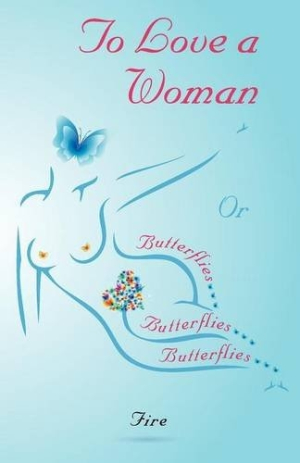To Love a Woman
Or Butterflies, Butterflies, Butterflies...
When it comes to desire, butterflies aren’t only in the stomach—they can also flutter quite strongly a few inches lower. For two characters in Fire’s To Love a Woman, those butterflies are a constant presence, leading them to share more than a few intimate moments and to explore sex beyond physical connection.
At the start, it seems that the main character, Natalie, isn’t really butterfly material. Lost in a haze of suburban ennui, she reflects mainly on her own boredom, marching through predictable days of helping her mother with social events and tending to her husband’s needs. In creating Natalie, Fire is adept at articulating the character’s emotional nuances and turning her from a suburban stereotype into a multilayered, complex character who easily conveys her feelings of imprisonment.
Then Natalie meets her new neighbor Victoria, a married woman who brings passion and color to Natalie’s life. From their very first encounter, the women are drawn to each other, and it’s not long before they’re slipping away from a dull dinner party to start their own erotic adventures. As they continue to spend time together, their relationship deepens into love, but complications inevitably arise, given their marriages and the conservative slant of the town.
As Fire charts the course of Natalie and Victoria’s relationship, she expertly describes the thrill of initial attraction, particularly the kind that seems forbidden or foreign. However, Natalie isn’t exactly an innocent who questions her feelings or seems conflicted about her desires. Instead, she openly admits to herself that she wants to pursue Victoria, and after just some minor flirting, she becomes more aggressive in going after what she wants.
Fire details the women’s luscious physical encounters with just the right balance of explicit description and coy innuendo. As the women explore each other’s bodies, they also go deeper into their own emotions, and Fire’s lively writing style and brisk pacing help to make the characters fuller and richer as the novel continues. Their “butterflies” change from lust to true connection, and when that love is threatened, Fire shines in depicting conflict and creating suspense.
Occasionally, Fire stumbles when writing dialogue, particularly when Natalie is speaking; she often sounds stilted or unrealistic. Victoria, however, is a much more relaxed character, and that ease shows in her dialogue. Fire lets her swear casually, and that looser attitude gives her speech a natural tone that moves the story forward more easily.
Despite some sticking points in dialogue, To Love a Woman is an erotic exploration that is definitely worth taking.
Reviewed by
Elizabeth Millard
Disclosure: This article is not an endorsement, but a review. The publisher of this book provided free copies of the book and paid a small fee to have their book reviewed by a professional reviewer. Foreword Reviews and Clarion Reviews make no guarantee that the publisher will receive a positive review. Foreword Magazine, Inc. is disclosing this in accordance with the Federal Trade Commission’s 16 CFR, Part 255.

